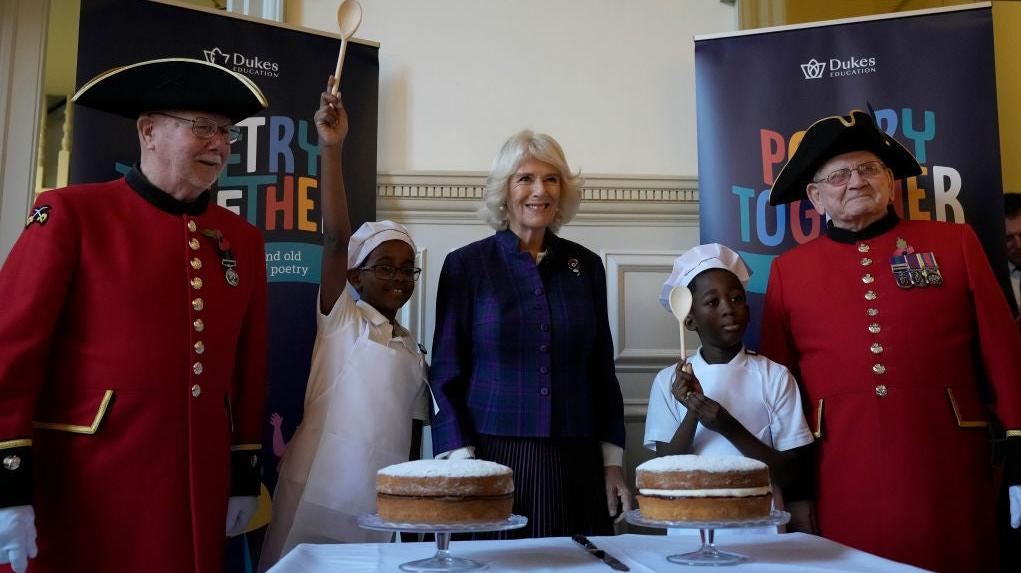Try Queen Consort Camilla's Favorite Cake Recipe
Queen Elizabeth loved tea parties, but Camilla’s specialty is cake.
Throughout her 96 years, the late Queen Elizabeth hosted some epic tea parties, or garden parties, as they are called across the pond. A typical Buckingham Palace event hosted 8,000 guests, who scarfed down a collective 20,000 tea sandwiches, at least one fruit tart apiece, and 27,000 cups of tea. (Think of the dishwashers you'd need...)
But what about Camilla, Queen Consort of the United Kingdom, previously known as the Duchess of Cornwall? It turns out that she's a fan of cake, and her favorite is a classic British treat, the Victoria Sponge.
What is a Victoria Sponge cake?
Named for another queen, it's a light, two-layered cake typically filled with jam or berries, plus whipped cream or sweetened clotted cream, and dusted with powdered sugar. The presence of cream means it has to be eaten quickly, or it turns into something like a trifle, which is about as good an excuse to have an extra slice as I can imagine.
However, Camilla's version of the cake has a naughty twist, which some might say is appropriate given that she and the newly crowned King Charles III famously carried on for years before their marriage. Rather than the traditional red filling of jam or berries, Camilla substitutes Nutella—she's an admitted chocolate fiend—or lemon curd. The former is rich; the latter cuts down a little on the cake's overall sweetness.
Camilla, an avid reader who runs a royal book group, shared her recipe last year when she was promoting a fundraiser for the Poetry Together Initiative, a charity that matches young people with seniors to read together. At the time, not many people were paying that much attention to what Camilla was baking. But now that she's the number one ranking British royal woman, and by Charles' side, she could easily tell the kitchen staff, "Let him eat cake." (Sorry.)
The Camilla sponge might not be as rich as First Lady Betty Ford's Double Chocolate Thanksgiving Cookies, but it is a cake you can make over and over again. I have baked dozens of Victoria Sponges, and the lightness means it can easily be digested by littles and elders alike, as well as those of us in between.
Queen Consort Camilla’s Victoria Sponge
- 4 oz. (1/2 cup) self-rising flour
- 1 tsp. baking powder
- 4 oz. (1 stick) softened butter at room temperature
- 4 oz. (1/2 cup) granulated sugar
- 2 large eggs
- 2-3 drops vanilla extract
- Filling of your choice
- 1-2 Tbsp. powdered sugar
Preheat the oven to 325 degrees Fahrenheit. Grease two 7-inch round cake pans and line the bottoms with parchment. (Larger cake pans will work, but the layers will be flatter).
Sift the flour and baking powder into a large mixing bowl, or pass it through a fine-mesh strainer. Add the other ingredients and whisk by hand or using an electric hand mixer. If the mixture seems too thick, add a tablespoon of warm water at a time until the batter can fall off a spoon.
Divide the batter between the two baking pans. Level off the tops, and bake for 30 minutes. Remove from the oven and let the cake cool for 30 seconds. Then, run a wet knife around the edge of each cake pan and carefully tip the cake layers onto a wire rack. Once they're cool, peel off the parchment paper. Fill and stack the cake layers, dust with powdered sugar, and serve.
Recipe courtesy of the @ClarenceHouse Instagram Account
Tips for baking Victoria Sponge cake
The cake ideally should be consumed in one sitting. You can refrigerate leftover cake, but it will get soggy if you have used a cream filling.
Try different types of spreads for the filling, such as the dark chocolate tahini sold by Soom Foods, or the Sicilian pistachio cream available from 177 Milk Street. You can use red bean paste, or any type of nut butter, sweetened to your liking. Just make sure the filling is spreadable, because it's easy to damage the sponge.
If your powdered sugar is clumpy, shake it over the cake through a small sieve. The top of this cake is ideal for a stencil—maybe a crown or a corgi?
